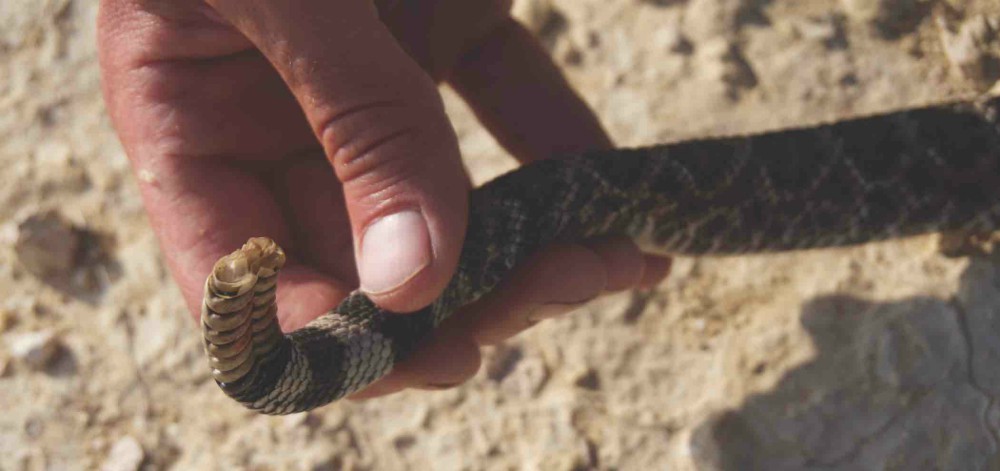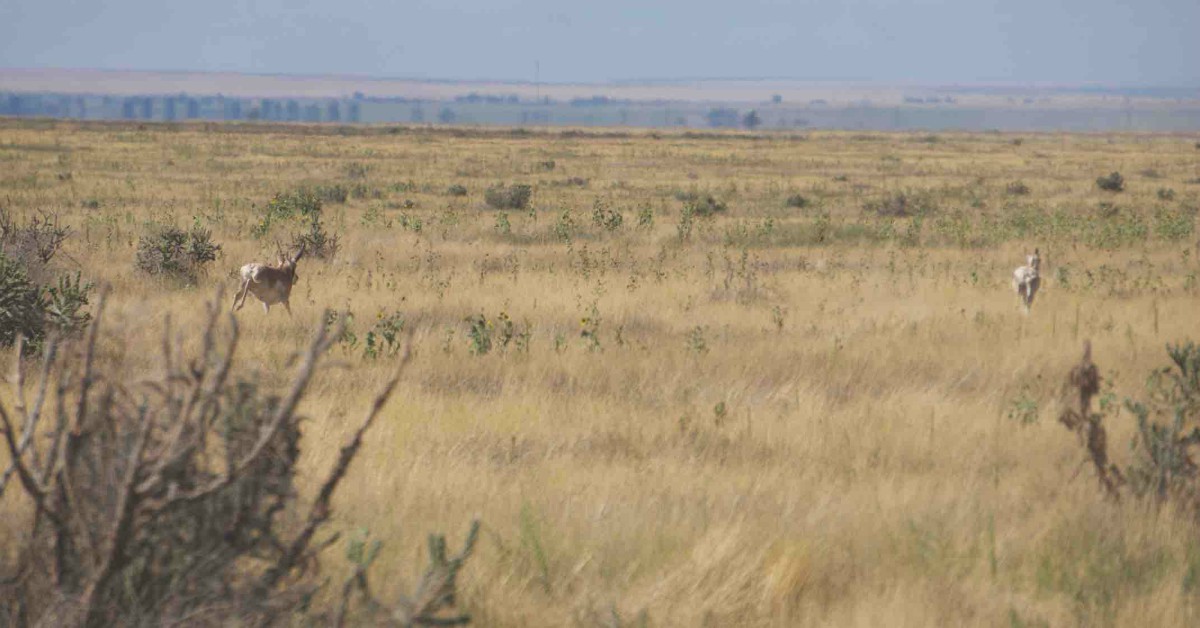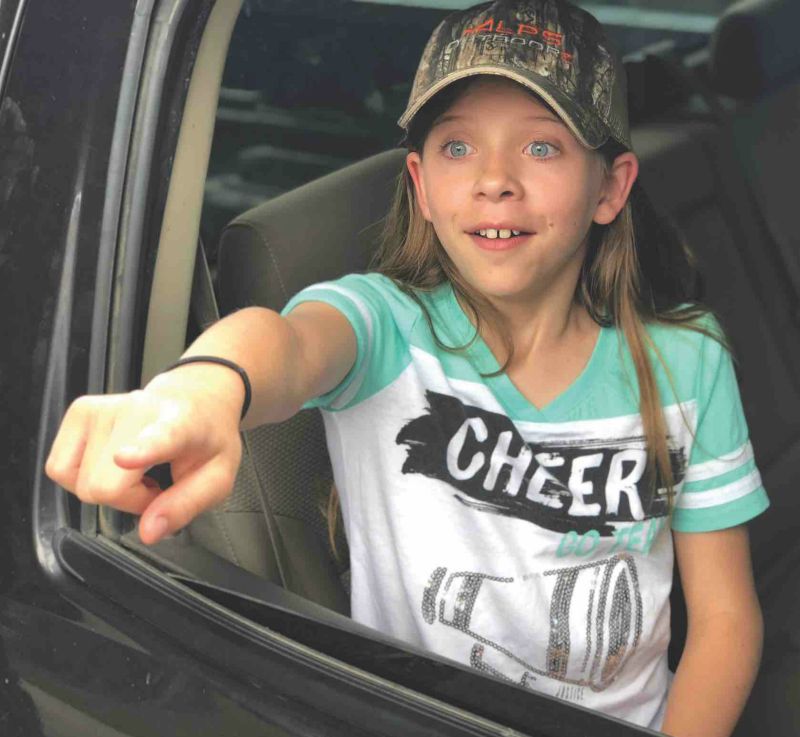The typical short, crunchy prairie grass was gone. In its stead stood calf-high shoots of green galleta and grama grass. Dry pond beds bubbled with fresh water, and the unquenchable August heat had been replaced with spring-like temps. I’ve never seen my little Colorado nook look so good. The cattle were fat, and the meandering pronghorn could sink their heads into the lush vegetation and graze with little effort.
It was the season’s third day, and I’d yet to come to full draw. Bowhunting pronghorn in an area typically plagued by drought, I’d grown accustomed to propping up my ground blind over a well-used waterhole and waiting. This year, Mother Nature had eliminated that option. I didn’t fight it. In fact, I was kind of glad. I cut my bowhunting teeth slithering across the open plains, and the thought of not spending 13 hours a day in a ground blind excited me. I was back to my bowhunting roots — and enjoying every moment.
He was magnificent, a fine representative of Colorado’s southeast corner. His prongs (cutters) were well above his ears and appeared to be extremely thick. The wide and fat paddles were confirmed with a glance through my Nikon spotting scope. When the bedded buck would turn his head right or left, I could see the length. Both prongs were over 6 inches, which for an area where prongs typically lack, made my heart beat just a little faster. His mass was incredible; the heavy curled-in tips resembled cigar butts. As for overall length, he was every bit of 16.5 inches. He was a gagger goat to be sure, and one that would push the tape just over 80 P&Y inches.
The American Pronghorn
Considered by many to be the spirit of the American West, the pronghorn, commonly referred to as an antelope, is without question one of the most interesting and complex animals on planet Earth. Its scientific name, Antilocapra americana, means “American antelope goat.” Oddly enough, the pronghorn is neither antelope nor goat. Rather, the deer-like pronghorn is thought by scientists to be the sole surviving member of an ancient family. As a member of the superfamily Giraffoidea, the pronghorn’s closest living relatives are the giraffe and okapi.
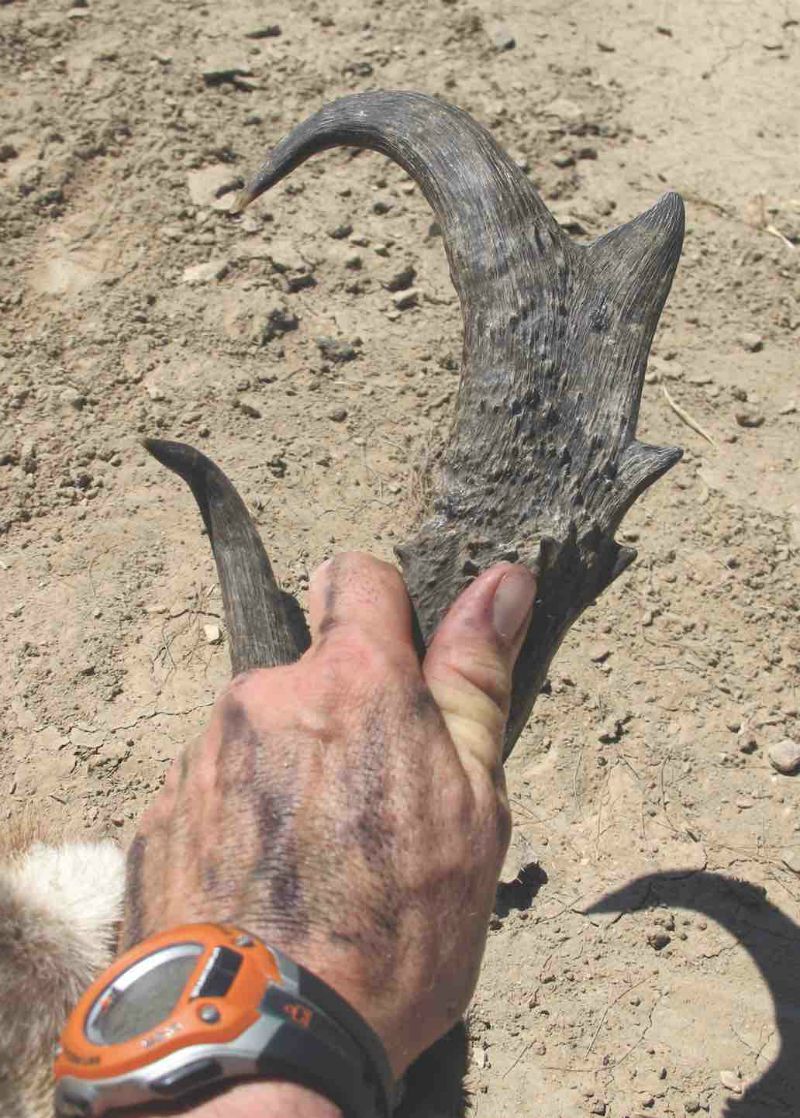 The only animal in the world with branched horns, and the only animal in the world to shed those horns as if they were antlers, the pronghorn possesses characteristics of both horned and antlered game alike. The pronghorn, like sheep, has a gall bladder, and, like giraffes, it lacks dewclaws. It’s no question these incredible critters were uniquely designed by an amazing Creator.
The only animal in the world with branched horns, and the only animal in the world to shed those horns as if they were antlers, the pronghorn possesses characteristics of both horned and antlered game alike. The pronghorn, like sheep, has a gall bladder, and, like giraffes, it lacks dewclaws. It’s no question these incredible critters were uniquely designed by an amazing Creator.
The fastest animal in the western hemisphere, the pronghorn can hit speeds upwards of 60 mph. Naturally, these plains dwellers use their speed to avoid predators, but it’s far from their only defense. The pronghorn boasts amazing eyesight — better than any animal I’ve ever hunted — and can pick you off from miles away. Their eyes are unusually large, about 2 inches in diameter, and are set well out on the sides of the head, giving them unparalleled 320-degree vison. Studies conducted by a number of respected animal biologists conclude a pronghorn’s vision rivals that of an 8X binocular.
Though they look large standing in the middle of vast spaces of grass, cactus and sagebrush, the animal is actually quite small when compared to deer. Typically weighing between 90 and 140 pounds (most mature males I’ve harvested weighed between 132 and 136 pounds), the pronghorn measures roughly 4.5 feet long and stands around 3 feet high at the shoulder. Bucks, especially as they age, have a pronounced black cheek patch, and as they age horn length increases. Each horn is composed of a slender, laterally flattened blade of bone that grows from the frontal bones of the skull, forming a permanent core. Like giraffes, pronghorn have a skin that covers the bony core, but over the skin grows a hair-like sheath. Does also have horns. Generally, those horns are not noticeable from a distance, but some will grow past the 3-inch mark.
Back to the Hunt
He wasn’t bedded in a great spot, but it wasn’t bad, either. In my early years of spot-and-stalk pronghorn hunting, I would go after any buck I saw. Not anymore. These days I prefer to play it smart and only make stalk attempts that offer a discernable level of success. You just learned about these creatures’ speed and eyesight in the previous biology lesson, and after hundreds of failed stalks, one develops a system about when to advance and when to yield.
The buck was nestled against some silver-tipped sage, bedded about 120 yards from the crest of small knoll. Getting to the knoll would be easy; covering another 60 yards across semi-open ground would be tricky. And, of course, he wasn’t alone. Because it was early in the season, the buck was surrounded by three other horns-not-even-above-their-ears youngsters and nine does. That’s a lot of 8X binoculars scanning for danger.
From what I could tell through my optics, there were a few scattered sage bushes between the knoll and the buck, and though the ground was covered in brittle white shale, a few sunflowers grew. I strapped on the knee pads, grabbed my gear and decided to give it a go. In tow was my 12-year-old son, Hunter.
Just as I figured, making the crest of the knoll proved no problem, but the cover between the buck and my position was sparser than I’d originally thought. Hunter hunkered into a sage and propped his binos up on a small tripod. He was staying put, and if needed, was going to give me a few hand signals.
Storm clouds were approaching from the west, and though I figured the arrival of cooler temps and possible rain would get the herd on its feet, I opted to wait for a few clouds to cast some shadows. I was going to be making some risky moves, and my pronghorn crawling tenure has told me that shadows really work in favor of the slow-to-maneuver bowhunter. Cautiously, lying flat on my belly, I began setting my bow out in front of me and inching along a few yards at a time. I never lifted my gaze toward the herd, but would rather look back toward Hunter. His eyes were glued to the binos, which told me all was well.
It took me 45 minutes to reach my last pre-selected sage bush. Inching out to the side, I was startled to see a bedded doe less than 25 yards away. She was napping in a small shale dugout and wasn’t visible during our initial glassing session. The buck was bedded beyond her, and my rangefinder confirmed the distance to be 64 yards. After loading an arrow, I tried to slowly rise to my knees, but the shale crackled and the doe spotted movement. She sprung from her bed, whirled and faced me head on. Then came a series of foot stomps and what I describe as a “kazoo-like” noise pronghorn make when alarmed. Of course, this brought the entire herd to its feet.
He was bigger than I’d originally thought. In fact, after 13-plus years of bowhunting these magnificent animals, he was the biggest buck I’d ever laid eyes on. His coal-black horns were thicker and more massive than I expected. Much like a non-typical whitetail, the buck had a number of small character points jutting this way and that. The upset doe finally took a step to her left and I drew, but by the time I could settle my pin, the buck and his herd were bounding away.
Just know that nine times out of 10, that will be the end result of your pronghorn stalk — a number of diaper butts bounding away at an alarming speed. But when the stars align and you’re able to connect, it doesn’t get much sweeter.
Here We Go Again
The great thing about pronghorn hunting with archery tackle, if you’re in an area that holds a decent population of speed goats, is the fact that your next stalk is often only a ridge or two away. Pronghorn, because of the open areas they call home, aren’t hard to locate if you cover country and put your optics to work.
After walking back to the truck, Hunter and I ran to town to pick up my bride, Amy, and other two children, Abbey and Brody. In the Bauserman household, bowhunting is a family affair, and a truckload of Bausermans rolling down no-name dirt roads in August is a common sight on the Colorado plains.
My wife had taken the helm shortly after the noon hour. Much of the terrain I hunt is pancake flat, so there are many times when hiding the truck isn’t possible. Having Amy drop me off is an efficient way to combat this.
By 5 p.m. Hunter and I had made three other stalks, and though we’d gotten bowhunting-close on two of them, no arrows were flung. We were tired, hot, and to be honest, a little disgusted. Our last encounter had put us 43 yards from a buck, but I’d marked the buck behind a different cactus during my pre-stalk planning. While scanning the area around the cactus, the buck rose to my left and peeled out of the area.
It was my fault, and I know better. I cut my typically-always-followed pre-stalk routine short. I didn’t take photographs of the cactus I wanted to get to with my small digital camera, and I didn’t take note of my position in relation to my estimated position of the buck on my GPS. The result was a botched stalk that should have ended with a 43-yard chip shot.
Hydrating back at the truck, the boss (my bride) decided we needed to take a spin down Death Road. Truth be told, I have no idea what the name of the road is, but because we’ve killed a number of goats in the area that the road dissects, we dubbed it accordingly.
“Right there,” my daughter Abbey said, her little finger shaking and pointing out into the sunflowers. Amy stopped the truck and I lifted my binos. Sure enough, a single pronghorn buck was making his way through the maze of yellow and black. He was about 1,000 yards out, and to this day I still have no idea how my daughter spied him. I took a moment to size him up and deemed him worthy of an arrow. It was a low-percentage play because the buck was traveling fast and light was fading. My only option was to slip in behind him and dog him. His body language, head down — horns tilted slightly forward, and a slow but steady gate — told me he was very relaxed.
The fading low light (my favorite spot-and-stalk condition) married with the patches of 5-foot-tall sunflowers allowed me to cover ground quickly. Because pronghorn have amazing 320-degree vison, I did my best to stay right behind the buck’s rump. It worked.
In less than 25 minutes, I’d closed the gap to 78 yards. The unaware buck had stopped to graze for a moment, and I quickly crawled closer. At 64 yards, I had an unexpected encounter with a prairie rattler that rose up out of the grass like a ghost. One of my biggest fears has always been being bitten on the face, and this was as close as I’ve ever gotten. Slowly, I crawled backward, keeping one eye on the coiled serpent and the other on the buck. Luckily, the snake permitted my retreat, and it slipped back into the grass and slithered away.
My heart was in my throat, but thankfully the buck hadn’t moved. I hit the range again — 64 yards. Drawing back, I settled my single-pin Spot-Hogg Hogg Father on the buck’s side and pulled through my release. The shot was perfect, and the buck collapsed within sight.
I will never get over the overwhelming sense of accomplishment that comes from DIY spot-and-stalk hunting, and knowing that my wife and kids watched this one go down through the lens of a spotting scope and few pairs of binoculars made it all the sweeter.
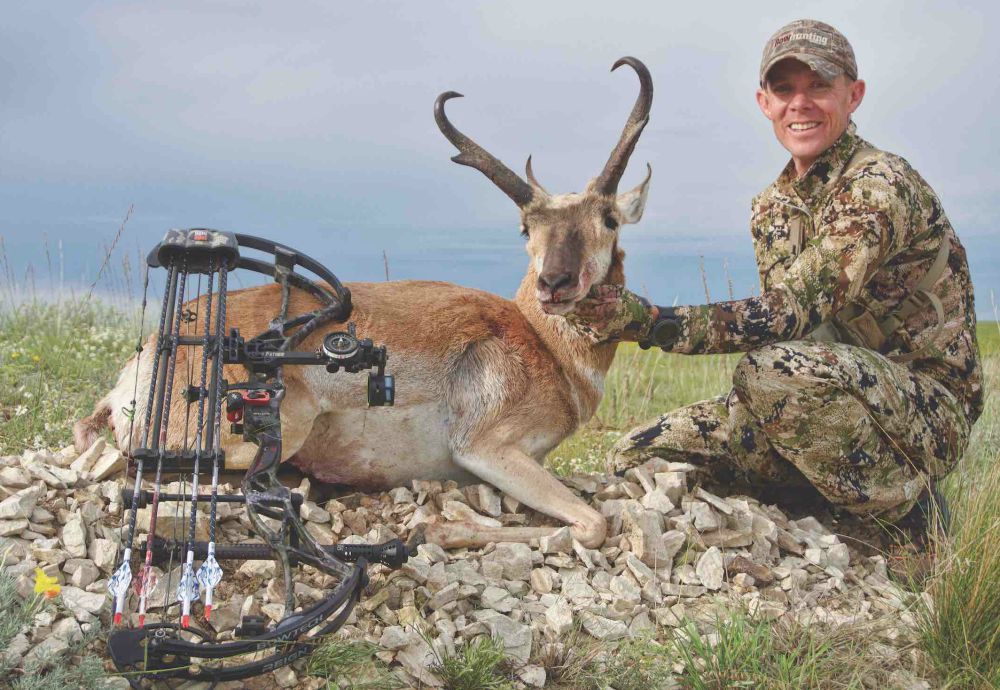
After a number of unsuccessful stalks, the author’s persistence was rewarded with a gorgeous DIY Pope & Young pronghorn.
What’s New in Archery Gear:
First Look: ScentLok OZ Radial 400B Portable Ozone Generator
Bowfile — Lakewood Products’ Best Back-of-the-Truck Bow Case
SITKA Gear Early Season Whitetail System Now Available

